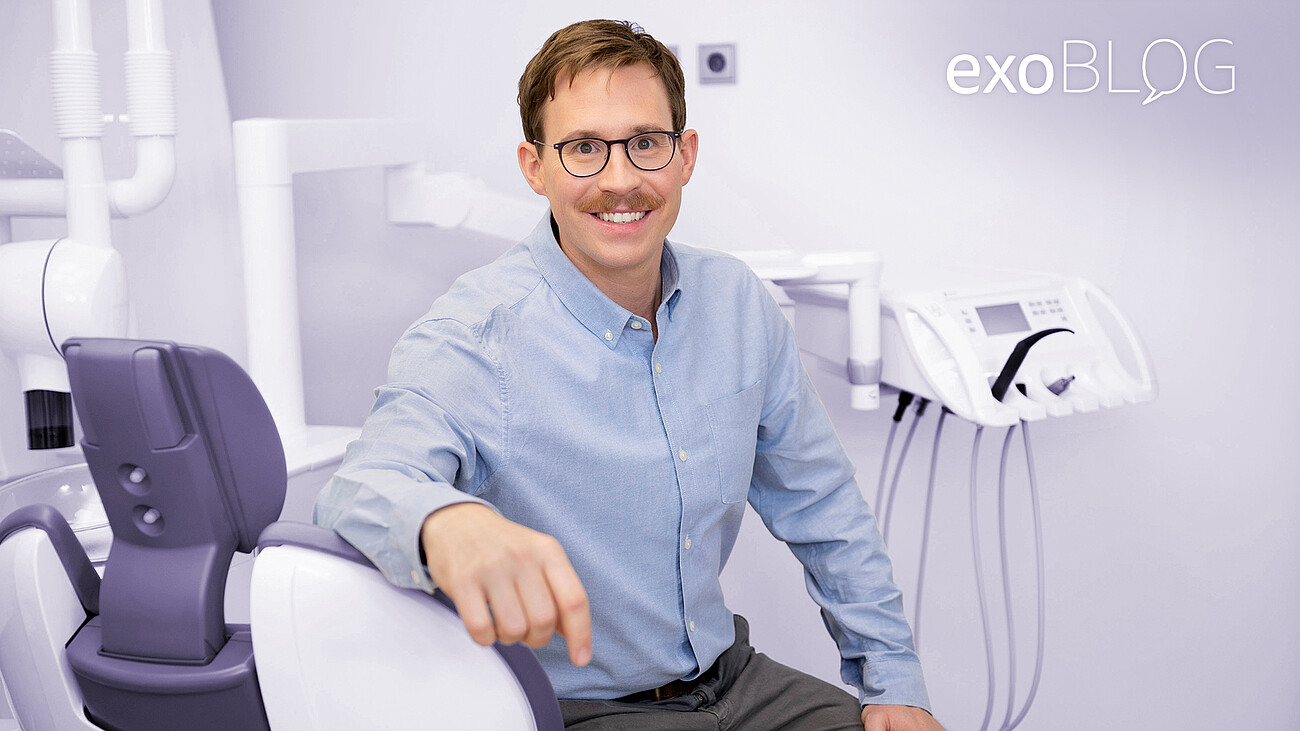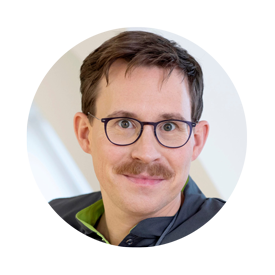Building buzz around a new digital practice
German oral surgeon Dr. Jan-Friedrich Dehner is a keeper of bees, sailor of seas, proud papa to two small children and a new practice owner. Jan opened his dental practice in the picturesque Bavarian town of Ochsenfurt, Germany, at the start of 2021. In this exoBlog conversation, Jan shares tips on how to scale up a practice and stoke patients’ curiousity about digital dentistry.
Q: How did you get involved in digital dentistry?
A: I’ve always been fascinated by the technical side of things, and, in dentistry, the technical developments are often the game changers in the industry. Like, right now, I have the feeling that we’re crossing a digital border. That’s why I decided it was the right time to open my own surgical studio. We opened in January 2021, with the clear aim to integrate as much digital technology as possible.
Q: Sounds like a good goal. How challenging was it?
A: Of course, it’s a matter of money and manpower because the dental assistants who were there at the beginning did not have a lot of experience with digital, but after one year, we are quite happy. We have three dental assistants, one dentist and 10 computers here. Everybody is working on the computers all the time, and there are only three dental chairs. Digitalization is a big, big, big part of the studio.
Q: What were the most important building blocks for your digital practice?
A: When you’re deciding how to become digital, first you talk about the needs and then about the wants. The need is a digital radiography. The images are digital. Everything is digital on the screen. For the implants, you also need a kind of a model. And this is where, I need to be honest, I was not able to afford an intraoral scanner just yet. I bought a model scanner, and we're doing plaster models right now. This is okay for the planning, but if there is enough patient traffic, we will buy an intraoral scanner in the future.
Q: So that’s the hardware. What kind of software do you use?
A: We do have lots of software to make our life easier. We have a radiography program, a patient coordinating program, and a little thing that I really love called a desktop communicator. If I'm here at my desk, which is 50 meters away from the patient's chair, my team sends me a message that they are prepared in room number one, and then it is not necessary for them to come get me. All of these digital programs make our work easier.
“What I have found with exocad is that the software provides a lot of solutions for problems that I did not yet even imagine.”
Q: Which exocad software do you use in your practice?
A: As I'm doing only digital splints for the drilling guides, I use exoplan. I started working with exoplan about three or four years ago during my former work at the university clinic. There we built up a workstation based on exoplan. We had a scanner. We had exoplan and a printing machine, a 3D printer. This was working quite well. When we got started here with all the guides that I needed to print, I decided to come back to exocad because it was a great experience. And because digitalization is like a barrel without bottom.
Q: You wrote about that in the magazine “Dental Implantology and Periodontology,” where you’re editor-in-chief, right?
A: Yes, I said: ‘Everything is possible!’ This is what you need to understand. You need to first define your problem and then you will find the solution. What I have found with exocad is that the software provides a lot of solutions for problems that I did not yet even imagine!
Q: How does being digital impact your workflow?
A: I’m a dental surgeon. exoplan helps me with the implant planning and the drilling guide. This saves me a lot of time because I don't need to send radiography and impressions or a digital situation out externally. I can do it here whenever I want or whenever I can. This is the first factor. Everything is in-house. This saves a lot of time. The patient shows up, and you can have everything prepared the next day.
“Before, the patients didn't know what was happening in their mouths. Now, I can show them.”
Q: How aware are patients of the digital side to their treatments? How do you build a buzz?
A: Well first it was important for my local colleagues to understand the technology I’m using because they’re referring patients to me. They’re the first step with advertising. Then, I also thought a lot about what to name my studio. I wanted something outstanding. I decided on the name: “Fachzahnarzt Praxis,” which means a specialist dental practice, and I called it, “Center of Digital Implantology.” The local newspaper featured our practice and described our digital workflow very precisely. A lot of patients came to us after reading the article. They were curious about the technology. They assume that it is automatically better. And, of course, it is better because it's more precise, it’s faster and you don't only rely on the experience of the dentist. You also rely on technical facts.
Q: How important are the visualizations you do for patients?
A: The visualization is very important because it helps me in explaining treatments. Before, the patients didn't know what was happening in their mouths. Now, I can show them a radiography and say, ‘Here the tooth is broken or here that is missing some bone.’ That really helps. If I show them the six implants and how it will be with the prosthesis, they can imagine what's coming.
Q: What kind of training did you do with staff to get them ready for the new digital workflows?
A: It helped being a start-up business. The lack of patients that we had in the first months until May made for a really relaxed atmosphere here. We used the time to take a lot of courses. For example, we had an external trainer give a radiography training for an entire day. We also did a training on dental photography.
Q: How do trainings influence your staff’s engagement?
A: My staff is really engaged. For instance, when I asked who was interested in doing a training on dental scans, everyone signed up. The dental assistant’s job can be interesting if you give it the spice of new techniques, and if you give them their independence.
“ Everything needs publicity. You can’t expect that patients will just come and find you. You need to scream out that you’re here.”
Q: Do you have advice for colleagues starting out on the digital journey?
A: You should be able to connect with colleagues on the same eye level. Ask colleagues about their experiences and go step by step. You need help. Ask colleagues which scanners, printers and software have worked best for them.
Q: Okay, time for some fun questions. Manual or electric toothbrush?
A: Absolutely electric. I came to that conclusion really, really late, about five years ago, but it's heaven.
Q: Do you floss morning and evening?
A: Once a day. The rest is cosmetics.
Q: What's your passion?
A: It's sailing. I'm an offshore sailor.
Q: Favorite one day getaway?
A: A day trip to Rome and driving around the city with a Vespa.
Q: Do you have a mentor?
A: In all of my professional life, I’ve met people who have helped me. For example, right now I have a good contact to Dr. Batyr Kuliev. He trained me on exocad and then we developed a friendship. Now we talk about the industry, the digital evolution and life.
Q: Favorite podcast movie or book?
A: I have a big stack of books on my night table that I want to read. One book that I was able to stay awake for is called “Das schwächste Glied?: Erfolgreiches Fehlermanagement: Was Ärzte von Piloten lernen können.” The title in English is: “The weakest link? Successful error management: What doctors can learn from pilots.” The book is about a dentist who started helicopter flying. He talks about errors and about situational awareness. And this is like a huge travel to yourself because you can reflect on where you commit errors and why you are stressed during the day. This is a book that has really helped me change my habits.
Q: Any final advice for other dentists?
A: Everything needs publicity. You can’t expect that patients will just come and find you. You need to scream out that you’re here. Tell people what you offer. What’s worked the best for me living in the countryside are these small newspapers, and of course word of mouth. Patients say, ‘Your staff is so nice, and I don’t have pain.’ This is what works.
Jan-Friedrich Dehner began his academic career by studying dentistry at the Friedrich-Alexander University of Erlangen-Nuremberg, which he completed in 2008 with the state examination and his doctorate with magna cum laude at the Clinic for Oral and Maxillofacial Plastic Surgery, University Hospital Erlangen. He then began his professional career focused on the surgical specialty at the Clinic for Oral and Maxillofacial Plastic Surgery at the University of Frankfurt am Main. After this specific advanced training, he was awarded the specialty of oral surgery in 2012. This specialization enables him to perform all oral surgical procedures gently and precisely. In the field of jawbone reconstruction procedures, so-called augmentations, and the provision of dental implants, he has continued his education with the Implantology Curriculum of the German Society for Implantology e.V. as part of his steady post-graduate training and has achieved the activity focus of implantology. Dr. Dehner is the editor-in-chief of the journal “Dentale Implantologie und Parodontologie.” Check out Dr. Dehner’s practice and his adorable family on Instagram.

by Caitlan Reeg
Writer at exocad
Caitlan Reeg spends her days telling the world about the innovations her colleagues create. She’s passionate about healthcare, technology, and the ways the two interact to improve our lives. A former journalist, Caitlan has worked on staff at Dow Jones Newswires in Frankfurt and at the national public radio program Marketplace in Los Angeles.




